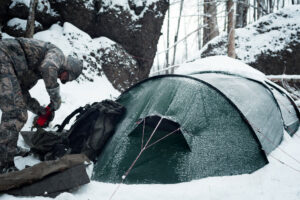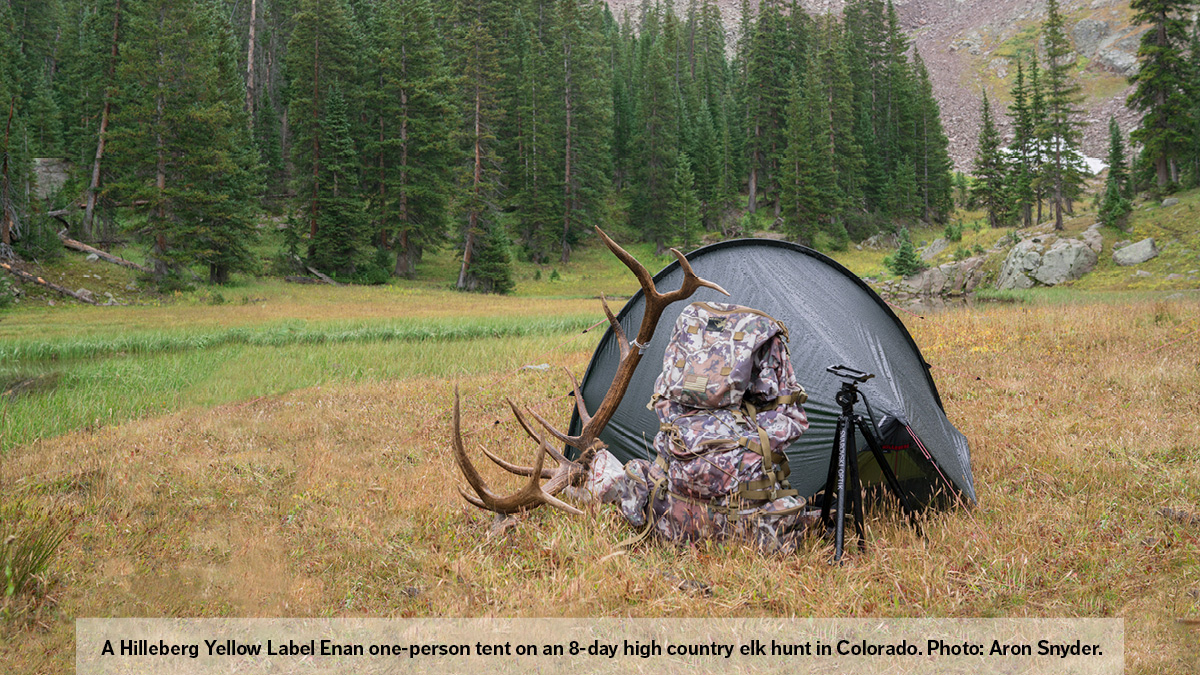During any hunt, “shelter” is always a priority. Having a refuge from the elements and getting good sleep can mean the difference between a great hunt and a miserable one. Hilleberg has been making top quality tents and shelters for nearly 50 years, so they have a great deal of experience with helping you get your shelter solution right.
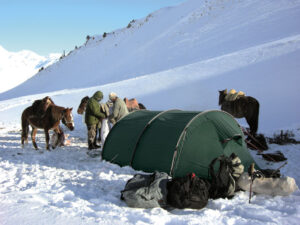
About Hilleberg
Since their founding in Sweden in 1971, Hilleberg has always gone their own way. In the early 70s they pioneered linked inner and outer tent construction, so that the complete tent pitches in one simple step, both ensuring the inner tent always stays dry and allowing each component to be used separately. This construction is still the hallmark of all Hilleberg tents. In the late 70s, they started exclusively using silicone-coated fabrics – the first tent company to do so – after discovering they had a much higher tear strength than other fabrics. It’s no different today: Hilleberg’s silicone coated Kerlon fabrics are typically many times stronger than most other fabrics on the market. In the 90s, when many companies moved production to China, Hilleberg established their own manufacturing facility in nearby Estonia so that they could maintain the high quality the company is renowned for.
Hilleberg tents and shelters are scrupulously function first. “We develop rather than design,” says Bo Hilleberg, founder and chairman of Hilleberg, and the head of product development. “We define the capabilities of the tent or shelter we want to make, then we engineer it to offer the optimal balance of strength, durability, ease of use and comfort, all at the lowest weight for its intended performance range. Finally, we test it, both in the lab, in our wind machine, and outdoors, often for years, before we will put it into our line.” Bo says the goal is not to make the lightest tents, but to make the strongest tents at the lowest weight possible for their intended use. Hilleberg believes that this method yields the highest performing backcountry shelter solutions available.
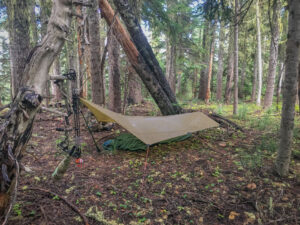
“Rather than the typical ‘4-season’ and ‘3-season’ tents, Hilleberg thinks in terms of ‘all-season’ and ‘snow-free season’ or ‘snow-free adventure’ tents,” says Petra Hilleberg, CEO and President of Hilleberg, and Bo’s daughter. The company’s Black Label and Red Label models are all-season tents, with outer tents that go all the way to the ground for maximum weather protection, all mesh areas inside capable of being covered with adjustable fabric panels, and all vents high up for optimal air flow in any weather. “These tents are just as functional on summer scouting or family trips as they are on late season, high mountain hunts,” says Petra. Yellow Label tents – Hilleberg’s “snow-free season” models – have mesh without covering panels, so their venting is permanently integrated into the construction. “We prefer the ‘snow-free’ designation because different climates have different periods – and length – of snow-free conditions,” explains Petra And while the Yellow Label models are Hilleberg’s lightest tents, they are also remarkably strong, capable of performing well outside their intended range – although, says Petra, “we don’t necessarily recommend that you use them that way!”
Regardless of the tent, the details on every Hilleberg model are built to handle all conditions of the tent’s intended performance range. Vestibules are large enough both for easy entry/exit and ample storage. Attached guy lines are strategically and precisely placed so that they will augment the tent’s strength in the toughest conditions. Zippers on both the outer and inner tents are of a size that offers both ease of use and durability, and outer tent zippers can be “locked” to prevent wind creep.
“We only compare a tent’s performance to our other tents: we don’t ever compare to any other brand,” says Bo. “And when we compare them, we talk about the differences in their margin of safety and level of comfort.” Bo explains that the margin of safety is effectively the “insurance” Hilleberg builds into their tents against both unforeseen occurrences and user mistakes. “It’s the ‘padding’ that you the user feel comfortable with in case things go badly,” he continues. “If you think you might get stuck in a snowstorm on many of your trips, or if you often travel in exposed terrain, more margin is a good idea; if you only go out in the summer, and always camp in the forest, perhaps you’re fine with less margin.” Every Hilleberg tent has a very high safety margin built in: All models have double wall construction, putting two layers between you and the elements, and all have their poles on the outer tent, so that if a pole breaks, it won’t puncture the tent itself. All Kerlon outer tent fabrics have a very high tear strength, providing greater longevity, and ensuring that if you were to get a hole in your outer tent, there is much less chance that it will become a trip-ending situation. The main difference between our Labels are the materials, with Black Label tents using the strongest materials and offering the greatest margin of safety, while Yellow Label models have the lightest materials, and Red Label tents fall between the two. As for level of comfort, says Bo, “it’s not how much luxury your shelter offers; it’s the comprehensive measure of a tent or shelter’s overall function. Does it have the right amount of room for the occupants, keep you dry in wet conditions, offer good venting capability in warm weather, and is it easy to set up in any condition?”
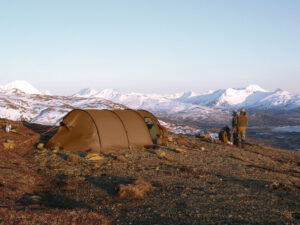
Choosing your shelter
Hilleberg recommends using the same margin of safety and level of comfort criteria when you choose your shelter. “Choose the lightest tent that does not compromise the strength you need for the worst conditions you’re likely to encounter,” says Petra. “Blindly buying into the ‘lighter is better’ argument, at the expense of the strength you need, can lead to, at best, a miserable hunt, and at worst, a dangerous situation.” The same, she adds, is true of the level of comfort. “If you take a tent made for snow-free use into the mountains and get snowed on, you’ll probably be fine, but your low comfort level may take away from your ability to perform at your best, which could ruin your trip, be it a hunt or a weekend of backpacking.”
Both the safety margin and level of comfort have a personal component of course: you have to decide what you’re willing to accept. Some want the maximum margin of safety and level of comfort; some are willing to sacrifice one or both for weight savings. Your choice has to be a balance of your experience – what you know you can do if things go sideways – and your ability to be honest with yourself about what you might run into on any given hunt.
Establishing when, where and how you travel in the backcountry is a huge factor in determining your shelter needs. You need to know the mix of weather you’re likely to encounter on your hunts, be that snow, rain, high winds or fine conditions. The terrain and locale are also important: will you be in exposed mountains or protected forests, in maritime or desert areas, or some mix? “How” you travel is a bit more involved. Are you usually solo, or with a partner or group? Do you more often set up and break camp each day or do you work out of a base camp and return every night? Are you out a good deal, or only a few days a year? This will give you a good place from which to evaluate what you want in margin of safety and level of comfort. “When someone asks us which tent to choose, we approach it from a ‘plan for the worst, hope for the best’ perspective, rather than a ‘plan for the best and hope it works out’ one,” says Petra. “Pick the shelter solution that will handle the worst of the conditions and terrain you’ll be in. When in doubt, we always encourage people to go ‘up’ a Label: If you’ll never be in snow and want the lightest weight, a Yellow Label tent is perfect. If you’ll be in the snow, or if you’ll be in more remote, challenging terrain, choose a Red Label tent. If you’re going to be out for long trips and/or in very exposed terrain and the worst kind of weather, or if you want the most comfort and greatest ease of handling, go with a Black Label model.”
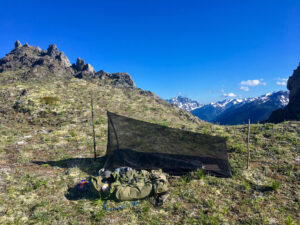
Shelter as a system
Alongside Hilleberg’s distinctive Black, Red and Yellow Label series is another, “unofficial” Label – their Shelters. This includes Tarps, Mesh Shelters and bivy gear, all designed both to offer minimalist options and to integrate with their tents for added versatility in different conditions. “’Shelter’ on my hunts is more than just about sleeping,” says Jon Dykes, the Hunting Manager at Hilleberg. “I might need something for glassing, cooking, or even just getting out of the weather during daily tracking and travel. Because Hilleberg tents and shelters work so well as a system, you can easily create a ‘shelter kit’ that will literally keep you covered no matter what you’re doing.”
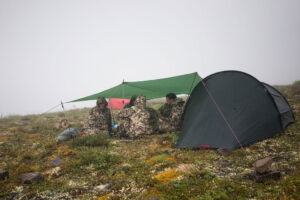
A basic “kit” that will cover nearly all situations would be a Hilleberg tent plus either a Tarp 10 (built for two) or a Tarp 5 (built for solo use) and their Bivanorak. This last, unique to Hilleberg, can be used as rain gear, bivy, sleeping bag cover, and temporary out-of-the-elements shelter. The tent is, of course, the anchor of the system. Use the Tarp as a separate “kitchen” (important in bear country) or as a group gathering space, for adding a covered “patio” area to supplement the tent’s already roomy vestibule, for glassing, or for protecting meat while you’re shuttling back to the vehicles. And, since the inner and outer tents on every Hilleberg model can be used separately, on hot weather journeys you can carry just the inner tent for protection from insects, snakes or scorpions and cover it with your Tarp 10 if it rains. As for the Bivanorak, “It is, says Jon, “a game changer for me. I use it for glassing, as rain gear and/or shelter during long, nasty weather days, or, since it will accommodate a sleeping bag and pad, for spiking out.”
If you’re of a minimalist bent, add Hilleberg’s Mesh Tent 1 to your kit. Built with a full floor and designed to pair with their Tarp 5 – it will work equally well with their bigger Tarp 10 – the Mesh Tent 1 takes care of bug protection while the Tarp keeps the rain off. “I find a Tarp 5, a Mesh Tent 1, and a Bivanorak is the ideal minimal kit for snow-free solo hunts, scouting or general backcountry hiking,” says Jon.
Like all your essential gear, your shelter choice deserves careful, thoughtful consideration. Be honest with yourself about your needs and your capabilities as well as what you’re willing to accept – or sacrifice –in both margin of safety and level of comfort. But since your shelter is crucial to the outcome of your hunt, choose wisely. “Your goal should be to sleep well and securely on your adventures,” says Bo Hilleberg, “not to prove how much misery you can endure every day and night.”
To learn more, visit www.hilleberg.com
